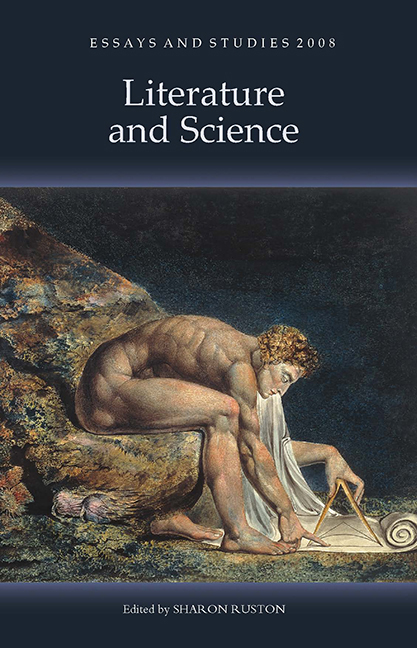Book contents
- Frontmatter
- Contents
- List of Illustrations
- Acknowledgements
- Notes on Contributors
- Introduction
- 1 From Popular Science To Contemplation: The Clouds Of The Cloud Of Unknowing
- 2 ‘Dreams And Plain Dotage’: The Value Of The Birth Of Mankind (1540–1654)
- 3 Natural Rights And Natural History In Anna Barbauld And Mary Wollstonecraft
- 4 George Eliot, Geometry And Gender
- 5 On The Back Of The Light Waves: Novel Possibilities In The ‘Fourth Dimension’
- 6 Le Fanu's ‘Carmilla’, Ireland, And Diseased Vision
- 7 Evolution, Literary History And Science Fiction
- 8 ‘The Luxury Of Storytelling’: Science, Literature And Cultural Contest In Ian Mcewan's Narrative Practice
- Index
6 - Le Fanu's ‘Carmilla’, Ireland, And Diseased Vision
Published online by Cambridge University Press: 12 February 2019
- Frontmatter
- Contents
- List of Illustrations
- Acknowledgements
- Notes on Contributors
- Introduction
- 1 From Popular Science To Contemplation: The Clouds Of The Cloud Of Unknowing
- 2 ‘Dreams And Plain Dotage’: The Value Of The Birth Of Mankind (1540–1654)
- 3 Natural Rights And Natural History In Anna Barbauld And Mary Wollstonecraft
- 4 George Eliot, Geometry And Gender
- 5 On The Back Of The Light Waves: Novel Possibilities In The ‘Fourth Dimension’
- 6 Le Fanu's ‘Carmilla’, Ireland, And Diseased Vision
- 7 Evolution, Literary History And Science Fiction
- 8 ‘The Luxury Of Storytelling’: Science, Literature And Cultural Contest In Ian Mcewan's Narrative Practice
- Index
Summary
JOSEPH SHERIDAN LE FANU's vampire narrative ‘Carmilla’ (1872) has come to prominence through two seemingly very different scholarly endeavors in the last twenty-five years. The first is Irish studies, given impetus by W. J. McCormack's (1980) political and literary biography of Le Fanu, which has sought to revisit Irish and Anglo-Irish literary history utilizing a historicist political methodology. The second is gothic studies, which has given ‘Carmilla’ a position of some esteem as a short story that can very profitably be examined by recourse to emerging theories of gender and sexuality. Recently, these two fields of study have moved closer together, generating a series of books and articles on the subject of Irish gothic, again led by McCormack (1998), and followed by Declan Kiberd (2000) and Richard Haslam (2007).
The role of science remains undeveloped, however, in both Irish and gothic studies and there has been no substantial analysis of its importance in Le Fanu's ‘Carmilla’. It would be commonplace to state that ‘Carmilla’ is a narrative of infection – a good deal of the criticism of vampire fictions would point to the metaphors of disease that Le Fanu employs – and uncontentious to point out that Irishness was often equated with disease and contagion. Yet there has been no critical assessment of Le Fanu's ‘Carmilla’ as an Anglo-Irish fiction that particularly examines theories of disease and their relationship to the cultural politics of Ireland.
It is the purpose of the present article to revisit ‘Carmilla’ in light of this absence, to consider the story as an important articulation of the intersection of Victorian disease theories with Anglo-Irish ethnicity that reveals how entwined were science and politics in the Victorian cultural imagination. The article therefore has two aims: first, to offer a new way of considering ‘Carmilla’ that interrogates its status as a gothic and Irish fiction; second, to argue that in the study of literature and science, science never remains unadulterated when it enters the public sphere, and that public understandings of science, as well as misunderstandings, are just as much a part of science as the theoretical and experi mental work of the scientist. To these ends, the article will interweave its discussion of the fictional narrative, disease, and Irish political and cultural history, offering, it is to be hoped, suggestive crosscorrespondences that illuminate Le Fanu's contribution to Victorian gothic and the Irish question.
- Type
- Chapter
- Information
- Literature and Science , pp. 111 - 130Publisher: Boydell & BrewerPrint publication year: 2008
- 4
- Cited by

